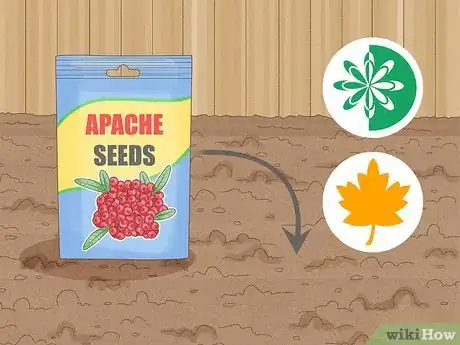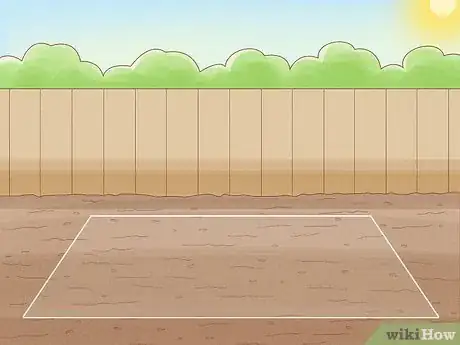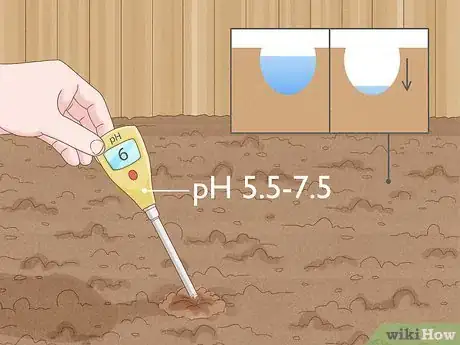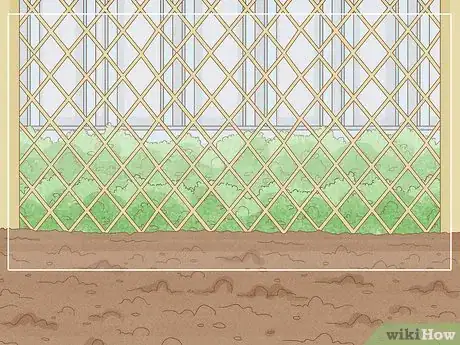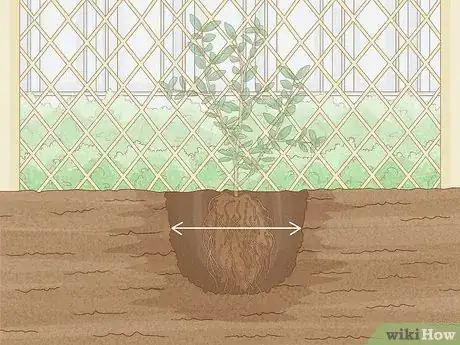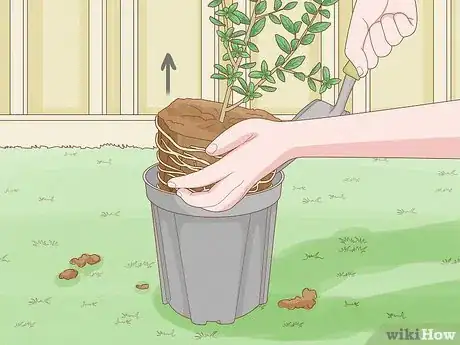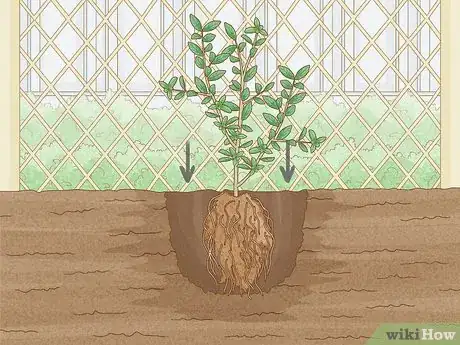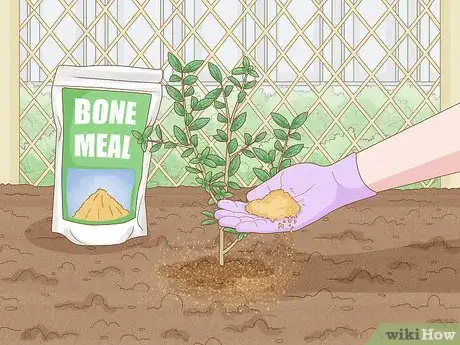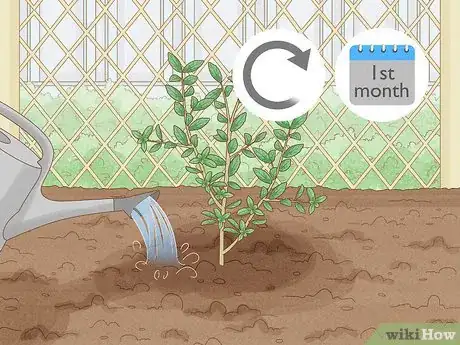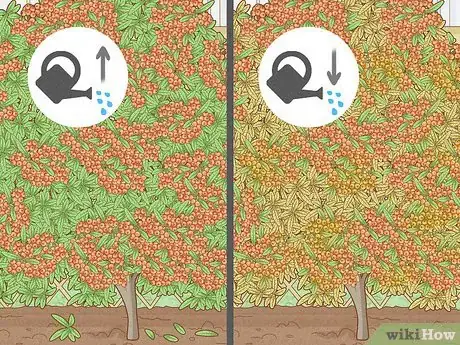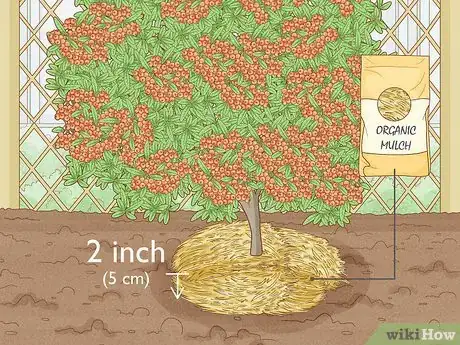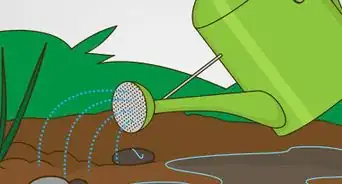wikiHow is a “wiki,” similar to Wikipedia, which means that many of our articles are co-written by multiple authors. To create this article, volunteer authors worked to edit and improve it over time.
wikiHow marks an article as reader-approved once it receives enough positive feedback. In this case, 100% of readers who voted found the article helpful, earning it our reader-approved status.
This article has been viewed 43,462 times.
Learn more...
Pyracantha, also known as firethorn, is a thorny evergreen shrub that produces bright red, orange, or yellow berry-like pomes. Grow the shrub by transplanting a young pyracantha into your garden. Once established, the plant is fairly low maintenance.
Steps
Preparations
-
1Select the right cultivar. Different cultivars have slightly different appearances. Choose one that best meets your personal taste.
- A few disease-resistant options include Apache, Fiery Cascade, Mohave, Navaho, Pueblo, Rutgers, Shawnee, and Teton.[1]
- Apache grows 5 feet (1.5 m) high and 6 feet (1.8 m) wide. It produces bright red berries.
- Fiery Cascade grows 8 feet (2.4 m) high and 9 feet (2.7 m) wide. It produces orange berries that gradually turn red.
- Mohave can reach heights and widths of 12 feet (3.7 m) and produces orange-red berries.
- Teton survives well in cold climates and can grow as tall as 12 feet (3.7 m) and as wide as 4 feet (1.2 m). The berries are golden yellow.
- Gnome is resistant to cold weather and produces orange berries, but it tends to be more susceptible to disease. It grows 6 feet (1.8 m) tall and 8 feet (2.4 m) wide.
- Lowboy grows 2 to 3 feet (0.6 to 0.9 m) tall but spreads out much further. It produces orange berries and is very weak against disease.
-
2Plan to plant in autumn or spring. Early to mid autumn is the best time to plant pyracantha, but if this season passes you by, the next best time to plant is early spring.Advertisement
-
3Choose a spot that receives full sun. All pyracantha varieties do best when planted in areas that receive full sun, but most can also survive well enough in areas of partial shade, too.
- Avoid areas that receive full western sun exposure since the sunlight can be too intense.
-
4Look for areas of well-drained soil. Pyracantha can tolerate different soils, but the plants generally do best in soils that drain well.
- This plant is actually a great choice for soils that aren't very fertile. Nutrient-dense soils can cause the shrub to become very bushy. As a result, it becomes weaker against diseases like fire blight and may yield less fruit.
- Note that the ideal soil pH for pyracantha is between 5.5 and 7.5. In other words, it does well in neutral to slightly acidic soils.[2]
-
5Consider training the plant against a wall or fence. Most cultivars have a tendency to spread out if they are not trained to grow against a tall surface. Planting the shrub near a bare wall or fence can encourage upward growth.
- Pyracantha has dangerous thorns. When the plant grows tall instead of wide, these thorns are kept out of reach.
- When planting pyracantha against a wall, choose a planting site 12 to 16 inches (30 to 40 cm) away from the wall itself. Soils directly next to the wall can be too dry.
- Avoid planting the shrub next to a painted wall, doorway, or gate since the thorns and prickly leaves can scrape away the paint.
- It is also recommended that you do not train the plant against the foundation of single-story buildings since it can grow too large and cause problems.[3]
Transplanting Pyracantha Shrubs
-
1Dig a hole twice as large as the root ball.[4] Use a shovel to dig a hole twice as wide as the container currently holding the pyracantha plant. The hole should be approximately the same depth as the container.
-
2Carefully remove the plant from its container. Tip the container holding the pyracantha on its side. Glide a shovel or trowel around the perimeter of the container to loosen root mass and soil, then gently wedge the plant out by applying pressure from the bottom.
- When removing a plant from a disposable plastic container, you can usually press on the sides of the container to ease the plant out.
- If removing the plant from a firmer container, slide the trowel down along one side of the container. Once it is as deep as possible, tilt the handle of the trowel back. The leverage should help pry the root ball out.
-
3Transfer the plant into the planting hole. Place the pyracantha in the center of the planting hole. Fill the rest of the hole in with soil.
- Make sure that the shrub is planted to the same depth as it was in its previous container. If you surround the stem with too much soil, it can weaken or kill the plant.
-
4Add as small amount of organic fertilizer. Sprinkle a handful of bone meal onto the soil around the base of the plant. Use your hands or a small garden fork to gently work it into the soil.[5]
- Bone meal is an organic fertilizer that adds phosphorus to the soil. It can encourage root development and make it easier for the plant to establish itself. If you want to use another fertilizer, make sure that you choose one that provides a high dosage of phosphorus.
-
5Space separate plants far enough apart. If you choose to plant multiple pyracantha shrubs, you should space each shrub 2 to 3 feet (60 to 90 cm ) apart.[6]
- Note that if you choose to plant multiple rows to create a thicker hedge, each row should be 28 to 40 inches (70 to 100 cm) apart.
-
6Water consistently as the plants establish themselves. Water the pyracantha regularly for the first month after transplanting it. It will need more water than usual as it establishes itself in the garden soil.
- The soil should receive a little water each day. If the weather forecast does not predict any rain for the day, lightly water the soil in the morning.
- The soil shouldn't be so soaked that puddles begin to form, but it is important that you do not allow the soil to completely dry out during this time. The plants will become too stressed and may begin dropping leaves.
Pyracantha Care
-
1Provide moderate water. Established pyracantha can survive mild to moderate droughts, but if the area has not received any rainwater in over a week, you should soak the soil around the base of the plant using a garden hose. Provide enough water to thoroughly saturate the soil.
- If the plant begins to drop leaves, it probably isn't getting enough water.
- If the leaves begin to turn yellow or if the wood of the plant becomes soft, it might be receiving too much water.
-
2Train the plant if desired. If you planted the pyracantha against a wall or fence, you can encourage it to grow upward and against this structure instead of growing outward.
- Most pyracantha cultivars are strong enough to hold themselves against a wall or fence without any assistance, but they will still benefit from being tied down.
- Run wires along your wall next to the pyracantha and tie the branches of the shrub to these wires with string or cable ties.
- If you are training the pyracantha against a fence or trellis, you can tie the branches directly to the structure using string or cable ties.
-
3Spread mulch. Spread a 2-inch (5-cm) layer of organic mulch around the base of each pyracantha shrub. Mulch can hold in moisture, thereby preventing the roots of the plant from weakening due to intense dry weather.
- Mulch also protects the plant from ground frost during cold winters
-
4Fertilize with caution. Fertilizer is usually unnecessary when you're dealing with pyracantha. If anything, nitrogen-rich fertilizers can do more harm than good.
- Nitrogen causes the plant to grow too many leaves. As a result, fruit yield suffers and the plant can be more susceptible to disease.
- If you do choose to fertilize the plant, use a balanced fertilizer containing equal parts nitrogen, phosphorus, and potassium or one containing more phosphorus and potassium than nitrogen. Apply it once during early spring and a second time during late summer.
-
5Prune three times a year. You can technically prune pyracantha during any time of the year, but many gardeners choose to prune these shrubs once in mid spring, once in early to mid fall, and once more in late fall to early winter.
- Wait until the plant finishes flowering in mid spring to remove new growth. Prune the new growth at your own discretion, leaving at least a few flowers so that fruit will develop in the fall. Note that fruit will only develop on growth that is at least one year in age.
- Prune the leaves of the plant when the fruits develop in early to mid fall. Remove just enough growth to expose the fruit to air and prevent it from rotting.
- Remove leaves and branches selectively in the late fall to early winter to accentuate the best of the brightly colored berries.
- No matter when you prune the plant, you should never remove more than one-third of the growth.
-
6Treat the plant for pests when necessary. Aphids, scales, lace bugs, and spider mites are the four pests most likely to appear. If an infestation of either one occurs, treat the shrub with an appropriate pesticide following the label instructions.
- If you plan to consume the fruit produced by the pyracantha, it is strongly recommended that you rely on organic pesticides rather than chemical options.
-
7Watch out for fire blight and scab. Fire blight is a bacterial disease that will kill the plant. Scab is a fungal disease that causes the plant to lose leaves and changes the fruit to a dark, sooty color, making them inedible in the process.
- Prevention is more successful than treatment when disease is concerned. Choose disease-resistant cultivars and maintain proper moisture and airflow conditions.
- There is no known cure to stop the spread of fire blight once it develops.
- If scab develops, you can attempt to treat the disease with a fungicide. This treatment may or may not be successful, though.
Community Q&A
-
QuestionWhy is my plant not getting flowers? Its on its third year.
 NinoxTop AnswererThe Pyracantha bloom on the previous year branches. If you cut the plant too much, there wouldn't be any bloom.
NinoxTop AnswererThe Pyracantha bloom on the previous year branches. If you cut the plant too much, there wouldn't be any bloom. -
QuestionCan pyracantha be grown in a large tub?
 NinoxTop AnswererThe pyracantha can survive in a large tub if you water it often. But the plant can become huge and not fit in the tub.
NinoxTop AnswererThe pyracantha can survive in a large tub if you water it often. But the plant can become huge and not fit in the tub. -
QuestionWhen can I plant saphyr rouge ?
 NinoxTop AnswererPyracantha can be planted in the spring or in the autumn. You should avoid the winter because the freeze can damage small roots.
NinoxTop AnswererPyracantha can be planted in the spring or in the autumn. You should avoid the winter because the freeze can damage small roots.
Warnings
- Note that consuming parts of the pyracantha plant can pose mild to moderate health concerns. The plant genus pyracantha belongs to contains plants that produce hydrogen cyanide. While pyracantha plants do not usually contain this substance, individuals with weak immune systems or weak lungs are still cautioned against consuming the fruit or any other part of the plant.⧼thumbs_response⧽
- After you've transplanted a pyracantha shrub once, it's best to leave it alone. The plant will weaken each time you transplant it, so changing its location multiple times can kill it quickly.⧼thumbs_response⧽
Things You'll Need
- Pyracantha plant
- Shovel
- Trowel
- Garden fork
- Bone meal or similar fertilizer
- Garden hose
- Organic mulch
- Pruning shears
- Pesticide (only as needed)
- Fungicide (only as needed)
- Fence, wall, or trellis (optional)
- Cable ties or string (optional)
- Wire (optional)
References
- ↑ http://www.clemson.edu/extension/hgic/plants/landscape/shrubs/hgic1072.html
- ↑ http://www.missouribotanicalgarden.org/PlantFinder/PlantFinderDetails.aspx?kempercode=e940
- ↑ http://utgardens.tennessee.edu/pom/firethorn.html
- ↑ http://www.gardeningknowhow.com/ornamental/shrubs/firethorn/care-of-firethorn-bush.htm
- ↑ http://www.pyracantha.co.uk/pyracantha-cultivation
- ↑ http://www.pyracantha.co.uk/planting-a-pyracantha-hedge

